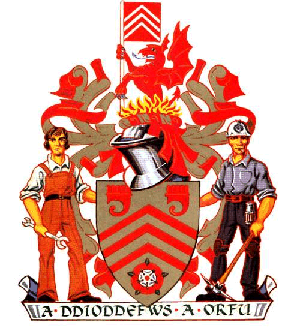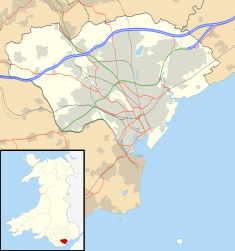
Cardiff University is a public research university in Cardiff, Wales. It was established in 1883 as the University College of South Wales and Monmouthshire and became a founding college of the University of Wales in 1893. It was renamed University College, Cardiff in 1972 and merged with the University of Wales Institute of Science and Technology in 1988 to become University of Wales College, Cardiff and then University of Wales, Cardiff in 1996. In 1997 it received degree-awarding powers, but held them in abeyance. It adopted the operating name of Cardiff University in 1999; this became its legal name in 2005, when it became an independent university awarding its own degrees.

Mid Glamorgan is a preserved county of Wales. From 1974 until 1996 it was also an administrative county with a county council.

Cathays railway station is a station on the Merthyr and Rhondda lines in the Cathays district of Cardiff, Wales. It is 1+1⁄4 miles (2 km) north of Cardiff Central.

Cathays Park or Cardiff Civic Centre is a civic centre area in the city centre of Cardiff, the capital city of Wales, consisting of a number of early 20th century buildings and a central park area, Alexandra Gardens. It includes Edwardian buildings such as the Temple of Peace, City Hall, the National Museum and Gallery of Wales and several buildings belonging to the Cardiff University campus. It also includes Cardiff Crown Court, the administrative headquarters of the Welsh Government, and the more modern Cardiff Central police station. The Pevsner architectural guide to the historic county of Glamorgan judges Cathays Park to be "the finest civic centre in the British Isles". The area falls within the Cathays electoral ward.

City Hall is a municipal building in Cardiff, Wales, UK. It serves as Cardiff's centre of local government. It was built as part of the Cathays Park civic centre development and opened in October 1906. Built of Portland stone, it is an important early example of the Edwardian Baroque style. It is a Grade I listed building.

Rhondda was a local government district in the geographical area of the Rhondda Valley, south Wales, from 1877 until 1996, with various statuses through its history.

Swansea Civic Centre – formerly known as County Hall – is the principal administrative centre of Swansea Council. Standing some 800 m southwest of Swansea city centre, by the seafront and overlooking Swansea Bay, the complex houses – in addition to the council chamber and offices – a public cafe, the central library, an exhibition space, archives service, and contact centre.

Cardiff Council, formally the County Council of the City and County of Cardiff is the governing body for Cardiff, one of the Principal Areas of Wales. The principal area and its council were established in 1996 to replace the previous Cardiff City Council which had been a lower-tier authority within South Glamorgan. Cardiff Council consists of 79 councillors, representing 28 electoral wards.

The County Hall is a municipal building located beside the disused Bute East Dock in the Atlantic Wharf area of Butetown, Cardiff. Formerly the home of South Glamorgan County Council, it is now the headquarters of Cardiff Council.

Cardiff City Council was the local government district authority that administered the city of Cardiff, capital of Wales, from 1974 until 1996. The district council replaced the pre-1974 county borough council. It was succeeded in 1996 by Cardiff Council.

Sir Percy Edward Thomas OBE was an Anglo-Welsh architect who worked in Wales for the majority of his life. He was twice RIBA president.

Cardiff Crown Court is a historic building situated in Cathays Park, Cardiff, Wales. The building is a Grade I listed building. As a Crown Court venue it is part of the Wales Circuit of His Majesty's Courts and Tribunals Service. The court house has nine courtrooms in addition to one "virtual" courtroom. The senior judge at the court is Judge Tracey Lloyd-Clarke, the Recorder of Cardiff.

The timeline of Cardiff history shows the significant events in the history of Cardiff which transformed it from a small Roman fort into the modern capital city of Wales.

Architecture in Cardiff, the capital city of Wales, dates from Norman times to the present day. Its urban fabric is largely Victorian and later, reflecting Cardiff's rise to prosperity as a major coal port in the 19th century. No single building style is associated with Cardiff, but the city centre retains several 19th and early 20th century shopping arcades.

Percy Thomas Partnership was the trading name of the award-winning British architectural practice established some time between 1965 and 1973 as the successor to a series of earlier partnerships originally set up by Percy Thomas (1883–1969) in Cardiff, Wales in 1911/12. Percy Thomas and the Percy Thomas Partnership put their name to a number of landmark buildings in the United Kingdom including the Wales Millennium Centre, Cardiff. It opened offices overseas and completed a number of prestigious buildings in Hong Kong.
Glamorgan County Council was established in 1889 together with the administrative county of Glamorganshire under the Local Government Act 1888. The first elections to the council were held in January 1889. The council was abolished under the Local Government Act 1972 on 1 April 1974. It was replaced by Mid Glamorgan County Council, South Glamorgan County Council and West Glamorgan County Council.

Mid Glamorgan County Council was the upper-tier authority for the Welsh county of Mid Glamorgan between its creation in 1974 and its abolition in 1996.

Cardiff County Borough Council, known as Cardiff City Council after Cardiff achieved city status in 1905, was the elected local authority that administered the town and county borough of Cardiff, Glamorgan, Wales between 1889 and 1974. The county borough council was replaced in 1974 by a district council, covering part of South Glamorgan and also known as Cardiff City Council.
Emyr Currie-Jones CBE (1917–2008) was a local Labour Party politician in Cardiff, Wales. He was Chairman of South Glamorgan County Council and known for his role in introducing Welsh-language education in Cardiff. He has been described as "an outstanding example of a local councillor who steered Welsh-medium education through many a political storm."























